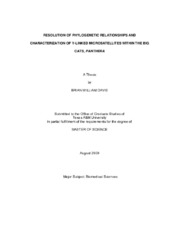| dc.description.abstract | The pantherine lineage of cats diverged from the remainder of modern Felidae less than 11 million years ago. This clade consists of the five big cats of the genus Panthera, the lion, tiger, jaguar, leopard, and snow leopard, as well as the closely related clouded leopard, which diverged from Panthera approximately 6 million years ago. A significant problem exists with respect to the precise phylogeny of these highly threatened great cats. Within the past four years, despite multiple publications on the subject, no two studies have reconstructed the phylogeny of Panthera with the same topology, showing particular discordance with respect to sister-taxa relationships to the lion and the position of the enigmatic snow leopard. The evolutionary relationship among these cats remains unresolved partially due to their recent and rapid radiation 3-5 million years ago, individual speciation events occurring within less than 1 million years, and probable introgression between lineages following their divergence.
We assembled a 47.6 kb dataset using novel and published DNA sequence data from the autosomes, both sex chromosomes and the mitochondrial genome. This dataset was analyzed both as a supermatrix and with respect to individual partitions using maximum likelihood and Bayesian phylogeny inference. Since discord may exist among gene segments in a multilocus dataset due to their unique evolutionary histories, inference was also performed using Bayesian estimation of species trees (BEST) to form a robust consensus topology. Incongruent topologies for autosomal loci indicated phylogenetic signal conflict within the corresponding segments. We resequenced four mitochondrial and three nuclear gene segments used in recent attempts to reconstruct felid phylogeny. The newly generated data was combined with available GenBank sequence data from all published studies to highlight phylogenetic disparities stemming either from the amplification of a mitochondrial to nuclear translocation event, or errors in species identification. We provide an alternative, highly supported interpretation of the evolutionary history of the pantherine lineage using 39 single-copy regions of the felid Y chromosome and supportive phylogenetic evidence from a revised mitochondrial partition. These efforts result in a highly corroborated set of species relationships that open up new avenues for the study of speciation genomics and understanding the historical events surrounding the origin of the members of this lineage. | en |


